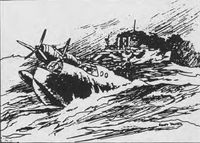- Author
- Zammitt, Alan
- Subjects
- Biographies and personal histories, RAN operations
- Tags
-
- RAN Ships
- HMAS Arunta I, HMAS Manoora I, HMAS Westralia I
- Publication
- March 1989 edition of the Naval Historical Review (all rights reserved)
Since the publication of Professor David Armstrong’s eulogy of his father, there have been a number of inquiries about some of the highlights of Jamie Armstrong’s Naval career particularly the 1940 Atlantic rescue of nine of its crew of the Sunderland, and Premier McKell’s unsuccessful recommendation in 1945 for the Captain to he Governor of New South Wales.
Alan Zammit who served in HMAS Australia in 1945 when the cruiser was commanded by Captain Armstrong and when Premier McKell took passage in the ship, has written this article about Captain Armstrong. It will be published in two parts.
Captain J.M. Armstrong, C.B.E., D.S.O. and U.S. Navy Cross died peacefully on December 30, 1988 at Jersey in the Channel Islands. He was 88 and had been in failing health the past eight years.
During the day days of 1940 the heavy cruiser, HMAS Australia commanded by Captain Robert Stewart, R.N., had as Executive Officer and Second in Command Commander John Malet Armstrong, known as ‘Jamie’ to his fellow officers, and nicknamed ‘Black Jack’ by the sailors.

In October 1940 Australia was searching for a suspected raider in the North Atlantic when a Sunderland Flying Boat came down in heavy seas north of the Hebrides in one of the worst Atlantic gales of the year. After the ditched aircraft commenced sending out weak wireless distress signals, Australia at 8 a.m. on October 29th was ordered to search for the disabled Aircraft. Captain Stewart and the Navigator, Commander J. Payment, R.A.N. (who died of wounds at Leyte four years later while still serving as Navigating Officer of the Australia) set a zig-zag search pattern course in a Force 8 gale. At first the cruiser pitched and rolled through the seas at 26 knots, but as the weather worsened speed had to be reduced. So severe was the gale that the forecastle was damaged and water leaked below decks.
In those early War days Australia was not fitted with radar. Visibility was only two to three miles, and extra lookouts were employed to search for any sign of the Sunderland. The flying boat was not in the position it had estimated but Australia located it by ‘homing’ in on the faint signals the aircraft was sending out from time to time. At 2.20 p.m. the Sunderland transmitted ‘Hurry up, cracking up’. Captain Stewart knew he was getting close. The ship made puffs of smoke, and a searchlight beam was swept across the bearing on which it was expected to sight the flying boat.
At 2.35 p.m. the Sunderland was sighted 2 miles ahead on the port bow, firing rockets and flashing ‘Hurry’ by Aldis lantern. As the cruiser approached, the flying boat capsized. For a time two of the airmen clung to the sinking aircraft’s upturned keel and the rest bobbed about in the raging, freezing sea. Captain Stewart manoeuvred his ship close to the airmen. Australia’s upper deck amidships was normally about 28 feet above the water line. However, with the roll of the ship and the state of the seas, at times the troughs of the waves were over 36 feet below the upper deck level. Over eight feet of hull and barnacle coated anti-torpedo bulges and bilge keel were exposed which could take a man to his death as the ship rolled.
Commander ‘Black Jack’ Armstrong, with a dozen of the ‘Aussie’s’ crew in bowlines, went over the side into the boiling North Atlantic sea and, using heaving lines, rescued nine of the aircraft’s crew of 13 from certain death in the icy water. The nine rescued were Flight Lieutenant Giddy, Pilot Officers Evans and Neugebauer, Sergeants Gough, Taylor and Cusworth, L.A.C. Gay and Mechanics Hicks and Bond. Midshipmen ‘Red’ Merson (now Commodore J.L.W. Merson, R.A.N.) (Rtd) recalled that the nine were practically helpless with cold and the effect of sea water. Captain Stewart reported in his War Diary that the remaining four were either swept under the ship or along the ship’s side. He saw two or three bodies to windward but then they disappeared. He got under way to place the ship in a position where it would drift down on them, but sadly the remaining four airmen were never seen again. At 5.25 p.m. after over two hours, the hopeless search for survivors in U-boat infested waters was reluctantly abandoned. All they were to have would be 60°:50′ North, 11°:35′ West as their Atlantic grave.




